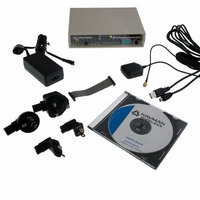AA003257-G Navman Wireless, AA003257-G Datasheet - Page 8

AA003257-G
Manufacturer Part Number
AA003257-G
Description
DEV KIT FOR JUPITER 32XLP
Manufacturer
Navman Wireless
Type
Receiver, GPSr
Specifications of AA003257-G
Frequency
1575.42MHz
For Use With/related Products
Jupiter 32 XLP
Lead Free Status / RoHS Status
Lead free / RoHS Compliant
Other names
943-1001
Available stocks
Company
Part Number
Manufacturer
Quantity
Price
Company:
Part Number:
AA003257-G
Manufacturer:
Navman Wireless
Quantity:
135
3.3 Timing 1 PPS output
The 1 PPS output of the Jupiter 32 xLP receiver is < 1 µs, typical ± 300 ns ref UTC. Refer to Table
6-2 for the default status on the Jupiter 32 xLP.
3.4 Power management
The Jupiter 32 xLP offers two kinds of power saving mode: Adaptive TricklePower and
Push-To-Fix (refer to Table 6-2 for the default status on the Jupiter 32 xLP). These modes can
be set using NMEA or SiRF Binary messages.
For further information refer to the Low Power Operating Modes application note (LA000513),
Navman NMEA reference manual (MN000315) and the SiRF Binary Protocol reference manual.
3.5 Differential aiding
3.6 Core processor performance
The standard Jupiter 32 xLP with GSW3 software runs at a CPU clock speed of 49 MHz.
An SDK (Software Development Kit) is available from SiRF to customise the Jupiter 32 xLP
firmware.
LA000267D © 2008 Navman Wireless OEM. All rights reserved. Proprietary information and specifications subject to change without notice.
3.4.1 Adaptive TricklePower
The Jupiter 32 xLP can use the Adaptive TricklePower (ATP) feature, which reduces power
consumption by intelligently switching between full power in tough GPS environments and
low power in strong GPS signal areas.
When signal levels drop, the receiver returns to full power so that message output rates
remain constant. This results in variable power savings but much more reliable performance
for a fixed output rate. Applications using ATP should give performance very similar to full
power, but with significant power savings in strong signal conditions.
ATP is best suited for applications that require solutions at a fixed rate as well as low power
consumption and still maintain the ability to track weak signals.
With ATP at a 1 second update, a power saving of 50% can easily be achieved with minimal
degradation in navigation performance.
3.4.2 Push-To-Fix mode
Push-To-Fix mode always forces the GPS software to revert to a continuous sleep mode
after a navigation position fix. It will stay in sleep mode until woken by activation of the
WAKEUP input (pad F4), and compute a fresh position.
If the ephemeris data become invalid, the RTC has the ability to self activate and refresh the
data, thus keeping the restart TTFF very short.
This mode yields the lowest power consumption of the module, and is ideal where a battery
powered application requires very few position fixes.
3.5.1 Differential GPS (DGPS)
DGPS is not available on the Jupiter 32 xLP.
3.5.2 Satellite Based Augmentation Systems (SBAS)
The Jupiter 32 xLP is capable of receiving WAAS and EGNOS differential corrections which
are regional implementations of SBAS. SBAS improves horizontal position accuracy by
correcting GPS signal errors caused by ionospheric disturbances, timing and satellite orbit
errors. Refer to Table 6-2 for the default status on the Jupiter 32 xLP.
























